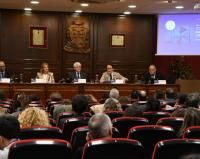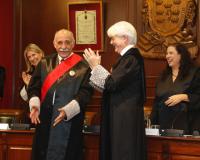
1. Hechos.
Copydan es la entidad de gestión danesa encargada de recaudar el canon por copia privada y cuya reclamación a Nokia del pago del canon por las tarjetas de memoria de los teléfonos móviles que esta compañía vende en Dinamarca es la causa de las cuestiones prejudiciales que aquí se examinan.
Con ocasión de este procedimiento, el órgano judicial danés planteó al Tribunal de Justicia una larga batería de cuestiones prejudiciales cuya resolución es reordenada por la Corte en una Sentencia inspirada fundamentalmente por un criterio esclarecedor de la regulación de la copia privada.
2. Pronunciamientos.
El Tribunal de Justicia aborda, en primer lugar, la cuarta cuestión relativa a la conformidad a Derecho comunitario de una disposición que sujeta al canon de copia privada soportes multifuncionales en los que la función principal puede no ser la realización de copias para uso privado. El Tribunal señala que no es relevante “que un soporte sea monofuncional o multifuncional ni que la función de reproducción sea, en su caso, secundaria con respecto a otras funciones” ya que se presume que los usuarios finales explotan todas las funciones disponibles. Ahora bien, naturalmente la cuantía de la remuneración debe fijarse “a la luz de la importancia relativa de la capacidad del soporte para realizar reproducciones de obras para uso privado”.
Seguidamente, el Tribunal trata la quinta cuestión relativa a la legalidad de un sistema de remuneración que grava las tarjetas externas pero exime a las memorias internas de los reproductores MP3. La corte aplica el principio de igualdad, consagrado en el artículo 20 de la Carta de los Derechos Fundamentales de la Unión, para señalar que el Derecho comunitario exige que no se traten de manera diferente situaciones que son comparables. Pero corresponderá al tribunal nacional examinar si las memorias en cuestión son comparables y si la diferencia de trato está justificada.
A continuación, el Tribunal examina la cuestión sexta en la que se somete a estudio el sistema danés de reembolso del canon por copia privada a los profesionales. La Sentencia formula su respuesta con carácter orientador de los principios que deben guiar al tribunal danés para decidir en el caso concreto.
La resolución señala que es posible imponer el pago del canon a profesionales que adquieren y posteriormente venden dispositivos grabadores siempre que existan dificultades prácticas para cobrar a los usuarios finales, y siempre que los profesionales con carácter general y no solo limitado a los que reconozca COPYDAN queden exentos del pago si acreditan que sus clientes son igualmente profesionales con fines manifiestamente ajenos al de la reproducción por uso privado.
La cuestión prejudicial que afronta posteriormente el Tribunal es la tercera y versa sobre la interpretación que debe darse a la posibilidad de no establecer compensación por un límite, cuando el daño causado mínimo tal y como explica el considerando 35 en relación al artículo 5 de la Directiva 2001/29/CE. El Tribunal explica que la fijación del umbral por debajo del cual el perjuicio puede calificarse de mínimo a estos efectos forma parte del margen de apreciación que se reconoce a los Estados miembros. En todo caso, esta discrecionalidad tendrá como límite el principio de igualdad de trato.
Resueltas las anteriores cuestiones, el Tribunal responde a los siete apartados en que se descompone la primera de las cuestiones prejudiciales. El primero y segundo tratan sobre la incidencia sobre la remuneración compensatoria de una potencial autorización otorgada por el titular para que los usuarios realicen copias privadas. El Tribunal considera que, cuando la Ley ha excluido el derecho del titular a autorizar las copias privadas, un acto de este tipo no tiene repercusión en la compensación equitativa.
Al responder a los apartados c y d de la primera cuestión, el tribunal aborda también la segunda cuestión prejudicial relativa a la incidencia que las medidas tecnológicas pueden tener sobre la compensación equitativa por copia privada. El Tribunal declara que la aplicación de medidas tecnológicas es de carácter voluntario y el hecho de que no se apliquen no conlleva la eliminación de la compensación equitativa como ya había dicho en VG Wort (C-457/11). Ahora bien, los Estados miembros sí pueden tener en cuenta la aplicación o no de tales medidas para fijar el nivel concreto de la compensación “a fin de incentivarlos a adoptarla y de que contribuyan así voluntariamente a la correcta aplicación de la excepción relativa a la copia privada para uso privado”.
El apartado f) de la primera cuestión prejudicial plantea una cuestión ya resuelta como es la aplicación de la copia privada a reproducciones efectuadas a partir de fuentes ilícitas. La Resolución del Tribunal repite en este punto lo ya decidido en la sentencia ACI Adam (C-435/12). La Directiva se opone a una legislación nacional que no distingue la situación en la que la fuente a partir de la que se realiza una reproducción para uso privado es lícita de aquella en la que dicha fuente es ilícita, puesto que “en semejante régimen, todos los usuarios que adquieren equipos, aparatos o soportes gravados por el canon se ven penalizados indirectamente” y, de este modo, quienes no realizan reproducciones de fuentes ilícitas, “han de asumir un coste adicional nada desdeñable por poder realizar las copias para uso privado cubiertas por la excepción previstas” por la Directiva.
En el apartado e) se examina si la copia privada ampara la realización de copias, usando el dispositivo de un tercero. El Tribunal señala en este punto que la descripción de los elementos que componen la copia privada no contempla la vinculación jurídica entre el “copiador” y el aparato con el que realiza la copia por lo que entiende que el legislador no ha considerado pertinente regular qué tipo de relación debe existir. Por ello concluye que la normativa europea no se opone a “una normativa nacional que establece una compensación equitativa por las reproducciones de obras protegidas efectuadas por una persona física a partir o mediante un dispositivo que pertenece a un tercero.”
3. Comentario.
Ante el gran número de cuestiones formuladas por el tribunal danés, la Corte de Justicia Europea realiza en esta Sentencia una auténtica recopilación de la doctrina que ya había pronunciado sobre copia privada a fin de dictar una suerte de guía de principios que permita al Tribunal del caso aplicar correctamente la ley comunitaria a su caso concreto. Hay, no obstante algún pronunciamiento novedoso como es el referido a la no exigencia de que el dispositivo que se use para realizar la copia pertenezca a la persona física que realice la reproducción privada.
(Fuente de la información: ANUARIO ELZABURU 2015, recopilatorio de comentarios de jurisprudencia europea en materia de Derecho de Propiedad Industrial e Intelectual que realiza Elzaburu).
Documento citado:
- Directiva 2001/29/CE del Parlamento Europeo y del Consejo, de 22 de mayo de 2001, relativa a la armonización de determinados aspectos de los derechos de autor y derechos afines a los derechos de autor en la sociedad de la información.
- Sentencia del Tribunal de Justicia (UE) Sala 4ª de 27 junio 2013
- Sentencia del Tribunal de Justicia (UE) Sala 4ª de 10 abril 2014
- Carta de los Derechos Fundamentales de la Unión
ENGLISH VERSION
Examination of the Danish private copying system in respect of aspects such as reimbursement, establishment of the amount of fair compensation, distinguishing among media and ownership of the device used to make the reproduction for private use. Judgment of the Court of Justice of 5 March 2015, Copydan (C-463/12).
1. Background.
Copydan is the Danish body responsible for collecting the private copying levy. Its claim to Nokia for payment of that levy in respect of the mobile telephone memory cards that that company was selling in Denmark is what prompted the reference for a preliminary ruling under analysis here.
In the context of those proceedings, the Danish court referred a battery of questions to the CJ, which reorganised them in a judgment that essentially sought to clarify how private copying is regulated.
2. Findings.
The CJ first of all tackled the fourth question concerning whether a provision that makes multifunctional equipment whose primary function may not be to make copies for private use subject to the private copying levy is in conformity with EU law. The Court pointed out that it is irrelevant “whether a medium is unifunctional or multifunctional or whether the copying function is, depending on the circumstances, ancillary to the other functions”, since it is assumed that final users will make use of all the available functions. Nevertheless, the amount of fair compensation payable must be established “by reference to the relative importance of the medium’s capacity to reproduce works for private use”.
The Court then turned to the fifth question relating to the lawfulness of a remuneration system that made external cards subject to the levy but exempted the internal memories of MP3 players from that levy. The CJ applied the principle of equal treatment, laid down in Art. 20 of the Charter of Fundamental Rights of the European Union, and indicated that, under EU law, comparable situations should not be treated differently. It nevertheless stated that it was for the national court to examine whether the memories in question were comparable and whether different treatment was warranted.
Next, the Court examined the sixth question concerning the Danish system of reimbursing business customers with the private copying levy. The CJ’s response set out the guiding principles to be followed by the Danish court when rendering its decision in the case in question.
In its judgment, it pointed out that it is possible to apply the levy to business customers who acquire and subsequently sell recording media whenever there are practical difficulties associated with collecting the levy from final users, and whenever business customers in general, not just those recognised by Copydan, are exempt from payment if they demonstrate that their customers are also business customers and that the cards supplied are for purposes clearly unrelated to copying for private use.
The CJ then addressed the third question, which touches on the interpretation of recital 35, in relation to Art. 5, of Directive 2001/29/EC, regarding the possibility of not establishing any compensation where the prejudice caused to the rightholder is minimal. The Court explained that setting a threshold below which the prejudice may be classed as minimal for the purpose of the above provisions must be within the discretion of the Member States. In any event, that discretion must be consistent with the principle of equal treatment.
Having answered those questions, the Court then turned to the seven parts comprising the first question that had been referred for a preliminary ruling. The first and second parts concern the impact of the rightholder’s consent for users to make copies for private use on compensatory remuneration. The Court considered that where a national law had excluded a rightholder’s entitlement to authorise private copying, such an act would not have any bearing on the fair compensation payable.
When replying to parts (c) and (d) of the first question, the CJ also tackled the second question regarding the potential impact of technological measures on fair compensation for private copying. The Court declared that the application of technological measures was voluntary, and that the non-application of those measures did not mean that no fair compensation was due, as previously indicated in VG Wort (C-457/11). However, the Member States can take account of whether or not such measures have been applied in order to establish the actual level of compensation so that rightholders “are encouraged to make use of them and thereby voluntarily contribute to the proper application of the private copying exception”.
Section (f) of the first question raises the previously resolved issue of the application of the private copying exception to reproductions made using unlawful sources. On that point, the Court reiterated its findings in the ACI Adam judgment (C-435/12). The Directive precludes national legislation which does not distinguish the situation in which the source from which a reproduction for private use is made is lawful from that in which that source is unlawful, given that “under such a system, all the users who purchase equipment, devices or media subject to that levy are indirectly penalised”, and those who do not make reproductions using unlawful sources “are thus led to assume an additional, non-negligible cost in order to be able to make the copies for private use covered by the exception” provided for by the Directive.
Section (e) of the first question examines whether the private copying exception covers reproductions made using a device belonging to a third party. In that regard, the Court pointed out that the description of the factors that make up the private copying exception does not specify the legal connection between the “copier” and the device used to make the copy, and so it is understood that the legislature did not consider it relevant to regulate what kind of relationship there must be. It therefore concluded that EU law does not preclude “national legislation which provides for fair compensation in respect of reproductions of protected works made by a natural person by or with the aid of a device which belongs to a third party.”
3. Remarks.
In view of the large number of questions referred by the Danish court, the CJ has used this judgment to create a genuine compilation of its doctrine on private copying and thus draw up a set of guiding principles, so to speak, to enable the national court to correctly apply EU law to the case in question. The judgment nevertheless contains a new finding, namely, that it is not necessary for the device used to make the copy to belong to the natural person who is making the reproduction for private use.
ElDerecho.com no comparte necesariamente ni se responsabiliza de las opiniones expresadas por los autores o colaboradores de esta publicación








